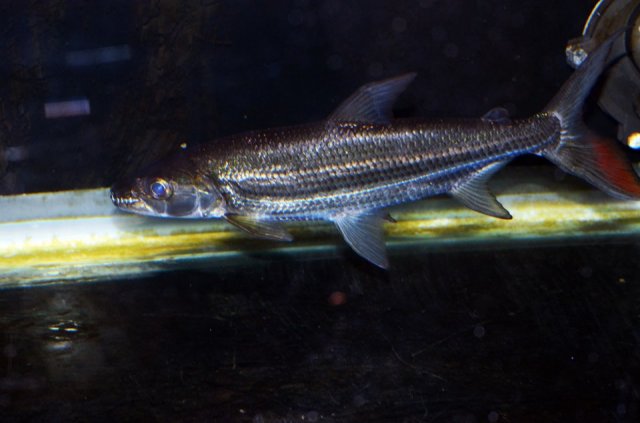Six GATF from Wes
- Thread starter thebiggerthebetter
- Start date
You are using an out of date browser. It may not display this or other websites correctly.
You should upgrade or use an alternative browser.
You should upgrade or use an alternative browser.
Thank you for your interest. They have been doing well, apart form an increased skittishness. The biggest are probably ~9"-10". The smallest ~8". Still love their cut fish which they get twice daily. I note they take my catfish farm pellet too. Still in a 240 gal with 27 pictus cats, five 6" tigs, 2 marbled lungs, 2 Luciobarbus, and a bunch of others.thebiggerthebetter any update on these
If God is willing, I will receive 10 more 3" GATF from Wes tomorrow morning. They are probably being packed or are flying right now. If I am lucky, we'll continue testing this theory of some GATF keepers of two kinds of GATF being out there, the ones growing 10x faster than the others.
Thank you for your interest. They have been doing well, apart form an increased skittishness. The biggest are probably ~9"-10". The smallest ~8". Still love their cut fish which they get twice daily. I note they take my catfish farm pellet too. Still in a 240 gal with 27 pictus cats, five 6" tigs, 2 marbled lungs, 2 Luciobarbus, and a bunch of others.
If God is willing, I will receive 10 more 3" GATF from Wes tomorrow morning. They are probably being packed or are flying right now. If I am lucky, we'll continue testing this theory of some GATF keepers of two kinds of GATF being out there, the ones growing 10x faster than the others.
I have read that as well. I lost my only GATF last month but picked up a nice 9.5 inch one yesterday they are really intriguing fish. I am thinking of getting a few more to keep him/her company as it seems they do better in packs than alone while at that size. Look forward to updates/videos when you have the time.
I wonder what
C
Chicxulub
has to say about the theory.
keep in mind they may become increasingly solitary as they grow, being a solitary predator in the wild.I have read that as well. I lost my only GATF last month but picked up a nice 9.5 inch one yesterday they are really intriguing fish. I am thinking of getting a few more to keep him/her company as it seems they do better in packs than alone while at that size. Look forward to updates/videos when you have the time.
What's might happen in the wild might not happen in home aquarium since these babies GATF never seen a violent rush flow of a real African rivers water 
There's a very real chance that there's something to Viktor's idea. As I have said many times in the community, there are at least six unique and undescribed genetic lineages of African tigerfish out there, one of which may be something very similar to H. goliath. I, too, have noticed two distinct body shapes of gatf in the hobby, each of which seems to display slightly different coloration. I must say however, a fast growth rate in ATF is something I've never seen personally or anecdotally. An inch per month is the best I've seen reported, and seems to be pretty consistent among keepers when they're in good care.
I wouldn't be entirely surprised if there were two giant but very similar ATF species in the Congo. There is, after all, already one of the undescribed ATF lineages in the hobby that we're calling the wrong name, and something we think we have almost certainly is completely absent. I just hesitate to broach the subject for fear of confusing the already difficult status of IDing these fish; though as I now work as a fisheries biologist and teach for UF, I am more and more feeling a moral obligation to do so in the interest of academic integrity.
The genus of Hydrocynus is by no stretch of the imagination completely sorted out yet.
Last edited:
That's why I chose my words right lol I said they may.What's might happen in the wild might not happen in home aquarium since these babies GATF never seen a violent rush flow of a real African rivers water
Thanks for the input. Pretty much like every other taxonomic group of fish lol that I'm into anyway.There's a very real chance that there's something to Viktor's idea. As I have said many times in the community, there are at least six unique and undescribed genetic lineages of African tigerfish out there, one of which may be something very similar to H. goliath. I, too, have noticed two distinct body shapes of gatf in the hobby, each of which seems to display slightly different coloration. I must say however, a fast growth rate in ATF is something I've never seen personally or anecdotally. An inch per month is the best I've seen reported, and seems to be pretty consistent among keepers when they're in good care.
I wouldn't be entirely surprised if there were two giant but very similar ATF species in the Congo. There is, after all, already one of the undescribed ATF lineages in the hobby that we're calling the wrong name, and something we think we have almost certainly is completely absent. I just hesitate to broach the subject for fear of confusing the already difficult status of IDing these fish; though as I now work as a fisheries biologist and teach for UF, I am more and more feeling a moral obligation to do so in the interest of academic integrity.
The genus of Hydrocynus is by no stretch of the imagination completely sorted out yet.
It's not my idea. I thinkThere's a very real chance that there's something to Viktor's idea. As I have said many times in the community, there are at least six unique and undescribed genetic lineages of African tigerfish out there, one of which may be something very similar to H. goliath. I, too, have noticed two distinct body shapes of gatf in the hobby, each of which seems to display slightly different coloration. I must say however, a fast growth rate in ATF is something I've never seen personally or anecdotally. An inch per month is the best I've seen reported, and seems to be pretty consistent among keepers when they're in good care.
I wouldn't be entirely surprised if there were two giant but very similar ATF species in the Congo. There is, after all, already one of the undescribed ATF lineages in the hobby that we're calling the wrong name, and something we think we have almost certainly is completely absent. I just hesitate to broach the subject for fear of confusing the already difficult status of IDing these fish; though as I now work as a fisheries biologist and teach for UF, I am more and more feeling a moral obligation to do so in the interest of academic integrity.
The genus of Hydrocynus is by no stretch of the imagination completely sorted out yet.
Also my post #13 here https://www.monsterfishkeepers.com/...o-reach-adult-size.687827/page-2#post-7756526
It's not my idea. I thinkgreenerinks is the inventor and the main proponent per https://www.monsterfishkeepers.com/...atus-african-tigerfish-16-in-4500-gal.683787/
Also my post #13 here https://www.monsterfishkeepers.com/...o-reach-adult-size.687827/page-2#post-7756526
The "fast growth" GATF reported in those threads are consistent with what I've seen out of GATF under ideal conditions. Admittedly, I too have noticed that there are two distinct shapes of GATF. I'm on the fence on this one. I've proposed for years that there could be two different lineages of goliath. When I brought it up in my gigantic Mad Max thread forever ago, the community chewed me up and spit me out though lol. I'm glad to see the idea is gaining a bit more traction.
It is worth noting that there is currently no KNOWN genetic evidence for the idea of two different lineages within Hydrocynus goliath. This is, however, based on the 2011 genetic survey that somewhat clarified the phylogeny of the group.... a survey that incorporated only 90 fish. The authors were quite clear in the fact that more work needs to be done in order to really grasp what's happening in this genus.
I haven't given up hope that a cryptic black goliath population exists. Indeed, I think they're already in the hobby, just not under ideal conditions for expression of the color. This also comes back as direct support for the idea that there's two lineages. Exhibit A:

Exhibit B:

Love to get you going lolgreenerinks I would REALLY like to read that paper you mentioned that stated that there were two subspecies of GATF. I haven't seen anything about that, and it would be super useful since I'm considering rewriting the sticky.
The "fast growth" GATF reported in those threads are consistent with what I've seen out of GATF under ideal conditions. Admittedly, I too have noticed that there are two distinct shapes of GATF. I'm on the fence on this one. I've proposed for years that there could be two different lineages of goliath. When I brought it up in my gigantic Mad Max thread forever ago, the community chewed me up and spit me out though lol. I'm glad to see the idea is gaining a bit more traction.
It is worth noting that there is currently no KNOWN genetic evidence for the idea of two different lineages within Hydrocynus goliath. This is, however, based on the 2011 genetic survey that somewhat clarified the phylogeny of the group.... a survey that incorporated only 90 fish. The authors were quite clear in the fact that more work needs to be done in order to really grasp what's happening in this genus.
I haven't given up hope that a cryptic black goliath population exists. Indeed, I think they're already in the hobby, just not under ideal conditions for expression of the color. This also comes back as direct support for the idea that there's two lineages. Exhibit A:
View attachment 1280937
Exhibit B:
View attachment 1280938


